More Medals for Team USA at the
2010 ARDF World ChampionshipsOpatija, Croatia, September 13 - 18

Team USA members after the award ceremony for the first competition day. Kneeling in front are Lori Huberman and Jen Harker, W5JEN. Standing, heads left to right, are Marvin Johnston KE6HTS, Harley Leach KI7XF, Dick Arnett WB4SUV, Ruth Bromer WB4QZG, Jay Hennigan WB6RDV, Alla Mezhevaya, Dennis Schwendtner WB6OBB, Karla Leach KC7BLA, Bob Cooley KF6VSE, Ken Harker WM5R and George Neal KF6YKN. Not pictured are Vadim Afonkin KB1RLI, Jerry Boyd WB8WFK, Dale Hunt WB6BYU and Kuon Hunt KB7WRG. (Photo by Ken Harker WM5R).
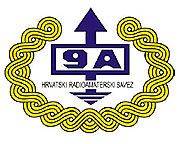
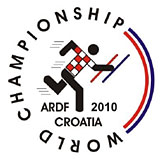 When I was a teenager and the space race was in full swing, it wasn't uncommon to hear someone ask, "How are we going to beat the Russians?" I hear the same question asked today, but in a much more friendly way.
When I was a teenager and the space race was in full swing, it wasn't uncommon to hear someone ask, "How are we going to beat the Russians?" I hear the same question asked today, but in a much more friendly way.
Former Soviet nations still have a juggernaut when it comes to on-foot hidden transmitter hunting at international competitions. They helped write the rules for this worldwide sport, which is called foxtailing, radio-orienteering and Amateur Radio Direction Finding (ARDF). Their best performers get regular training, supported by their governments and military. The Russian national anthem is heard most regularly at the medal podium, followed closely by the anthems of Ukraine, the Czech Republic, Slovakia, Poland, Hungary and so forth.
In about two dozen other nations, the radio-orienteers may not be as skilled or highly trained, and there may not be as many of them, but they are just as enthusiastic. That list of up-and-coming countries now includes two from North America: USA and Canada. The rest of the world has welcomed them and recognizes them as serious contenders.
Friendly Competition on the Adriatic
The Fifteenth World Championships (WC) of ARDF took place near Opatija, Croatia from September 13 through 17, 2010. Fourteen persons represented USA on the competitive courses, selected from the best performers at the USA ARDF Championships near Boston in 2009 and near Cincinnati in 2010. Through the summer, all of them continued to train and prepare. Some ran marathons, some went for map-and-compass orienteering sessions, and whenever they could, they all took opportunities to hunt radio transmitters in parks and forests. Two team "training camps" took place in the Los Padres National Forest north of Los Angeles, one in July and one in August. Each was two days long and included full ARDF courses on two meters and 80 meters, plus sprint courses in which the goal was to find each transmitter within 60 seconds.
Several of our team members arrived in Croatia during the week before the WC to take advantage of up to four days of field training offered by the event organizers. This was an opportunity to learn about the unique features of the Croatian coastal mountains, including its limestone deposits and depressions atop the hills that can't be easily discerned from the topographical orienteering maps that were provided.
Until 2000, ARDF WC events were usually headquartered on school campuses and participants were housed in dormitories. Because of the large number of participants nowadays and the limited number of suitable school facilities available in September, organizers now offer low-cost packages that include five hotel nights and all meals, buffet style. By Monday evening, 386 competitors from 32 countries had arrived and were settled in about a dozen hotels around the historic seacoast resort town of Opatija. That is, all except one national team that didn't get its lodging requirements to the organizers on time and had to camp out on the first night.
Team USA members slept in the Hotel Kvarner. It was built in 1884, twelve years before electricity came to the town, and for decades it was a winter hideaway for Austrian nobility. It was not the headquarters hotel for these events, but its Crystal Ballroom with eight large chandeliers was the site of the opening ceremonies and medal presentations. There are many other historic locations in the area including Lividraga, the favorite hunting lodge of Yugoslavia's Marshal Josip Tito, which was the finish point of the first day's competition.
On Tuesday, there was a two hour bus ride to the Model Event. It was an opportunity to meet old friends, to make new acquaintances and to test RDF equipment on very short courses. Before long, it was time to get back into the bus to return for dinner and pageantry.
Opening ceremonies of an ARDF WC are a miniature version of Olympic openings. Representatives of each country stand behind placards in a row as welcome speeches are given and local performers entertain. That night, they heard from the President of IARU Region 1, the head of the Croatian Amateur Radio Association, and the deputy Mayor of Opatija. Then everyone headed off for a good night's rest, because early the next day would be a two-hour bus ride to an unknown location near the Slovenian border for the first competition.
Two Courses in One
There is no "mass start" in championship ARDF. Each person is timed individually from start to finish. Groups of competitors take off at five-minute intervals that correspond to the times that transmitter #1 comes on the air. With hundreds of WC competitors nowadays, the start would take most of the day under the old system of one band per course, so recently revised rules now allow dual courses on each competition day. Each morning, there is a set of five two-meter transmitters and five 80-meter transmitters in different locations within the same forest, with start and finish points common to both.
On sunny competition day one, men ages 40 through 49 (M40) and all of the women hunted the 80-meter foxes, while all other men went after the two-meter ones. As many as eleven runners in different age/gender categories started every five minutes, so everyone was onto the course in three and a half hours.
More than one Team USA member recalls that the two-meter course on day one was the most difficult ARDF challenge he had ever encountered because of the signal reflections. For all five foxes, it was 3.6 miles (5.3 km) from start to each fox in optimum order and then to the finish, but such a direct route was impossible. "The optimal first transmitter was behind a hill and was giving a very strong signal," says Jay Hennigan WB6RDV. "Its strong bearings were mostly from a reflector that was outside of the map boundaries. I persevered, but by the time I found it, it was time to go to the finish before I was overtime. I was using gear that I wasn't familiar with because I broke my antenna at the practice and wound up using someone's spare. It must have had more gain, because I was always further from the transmitters than I thought I was."
Dale Hunt WB6BYU had similar problems: "I should have run up to the top of the first hill for a better bearing but I didn't, so I spent the first half of my time chasing reflections around. When I was near the point of giving up, I figured I was within two cycles of one transmitter, but it had gotten no stronger than it was when I was a kilometer away on top of a ridge. There were lots of trails marked on the map in some places. It was hard to tell from the terrain which were major, which were minor and which were unmapped logging spurs. It was really easy to miss trails because some were pretty faint, especially the ones that went through the limestone areas."
USA's best on two meters that day was George Neal KF6YKN, who placed eighth of 51 runners in the category for men ages 50 through 59 (M50). Gold medalist in M50 that day was Nikolay Ivanchihin UR8UA of Ukraine, who had been a visiting competitor at the 2009 USA ARDF Championships and had won two golds there. In the category for men ages 60 through 69 (M60), Bob Cooley KF6VSE placed twelfth and Harley Leach KI7SF placed fifteenth out of 48. That put Team USA in fifth place out of fifteen teams in M60.
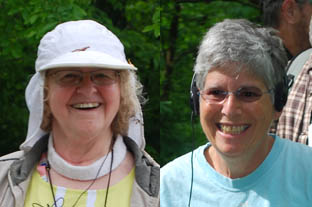 It was better on 80 meters, where signal bounces are rare and bearings are usually very well-defined. The team of Karla Leach KC7BLA and Ruth Bromer WB4QZG (pictured at right) received silver medals for being second only to the Russian team in the category for women over age 60 (W60). (Team scores in each category are aggregates of individual scores in that category. Competitors may not assist one another on the course.) KC7BLA has been participating in ARDF since 2000. This is her fourth time as a competitor in a WC and her first world medal. As a long-time member of Backwoods Orienteering Klub, WB4QZG was an expert at running in the forest with map and compass when she went to her first ARDF event last year near Boston.
It was better on 80 meters, where signal bounces are rare and bearings are usually very well-defined. The team of Karla Leach KC7BLA and Ruth Bromer WB4QZG (pictured at right) received silver medals for being second only to the Russian team in the category for women over age 60 (W60). (Team scores in each category are aggregates of individual scores in that category. Competitors may not assist one another on the course.) KC7BLA has been participating in ARDF since 2000. This is her fourth time as a competitor in a WC and her first world medal. As a long-time member of Backwoods Orienteering Klub, WB4QZG was an expert at running in the forest with map and compass when she went to her first ARDF event last year near Boston.
Among the individuals on 80 meters, Vadim Afonkin KB1RLI finished twelfth out of 51 in the category for men ages 40 through 49 (M40). His course time was only eleven minutes longer than the Russian gold medalist's.
Then the Rains Came
It is a WC tradition that after the first day of competition, there is a day of rest and relaxation before the second day in the forest. It was an opportunity for yet another bus ride to tour the ancient city of Porec. That evening the rain began, continued all night, and became a downpour as buses arrived at the site of competition day two. Starts were delayed, with the first group not setting forth until 10:30 AM.
After standing in a crowded tent, it felt good to get out on the course, even if it meant getting drenched and trying to plot bearings on a wet map board. "The rain was horrible," WB6RDV recalled, "but once you had been running in it for five minutes, you learned to just ignore it. The main problem I had was that Sharpie pens don't write on clear plastic map covers in the rain and my china marker wasn't much better. If I had been able to see the map marks well, I wouldn't have made a mistake that cost me a couple of transmitter cycles."
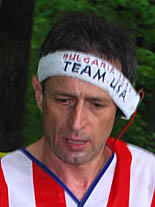 USA's best that day was KF6YKN (pictured at left), who captured a bronze medal in M50 category on 80 meters. George found all of his required four transmitters in just under 55 minutes, which was 97 seconds longer than the Estonian M50 gold medalist took. In M60 category, KF6VSE was seventh in M60, also on 80 meters.
USA's best that day was KF6YKN (pictured at left), who captured a bronze medal in M50 category on 80 meters. George found all of his required four transmitters in just under 55 minutes, which was 97 seconds longer than the Estonian M50 gold medalist took. In M60 category, KF6VSE was seventh in M60, also on 80 meters.
KF6YKN has been active in ARDF for much of his life. As HA3PA, George competed for his native Hungary. Then upon coming to the USA, he became a leader in developing the sport here by helping to train our team members. He was in USA's first delegation to the WC in 1998. This is the second time he has captured a WC medal for USA, the first being at the 2008 WC near Seoul, Korea.
Again, reflections plagued the two-meter hunters. The five-fox two-meter course was ten percent longer than the two-meter course on day one. Nevertheless, it was a good day for two women on our team. WB4QZG finished in fourth place in W60 on that band. Her time was fourteen minutes shorter than the bronze medalist, but Ruth found one less fox. Only one person in W60 found all three of the required transmitters for that category. Lori Huberman, who is Ruth's daughter, finished in fourth place in W21 category. She was one of only six W21 competitors who succeeded in finding all five two-meter foxes.
"I didn't trust most of my bearings," Lori reported. "I kept moving and only followed bearings that were consistent. I couldn't go to high places because there was only one big hill, out of the way on one corner of the map. The rest of the course was rolling hills and depressions. George and I had discussed where the transmitters might be before I went out, so I had a plan and I went to those areas. When I got to locations where I thought they might be close and signals were strong, I trusted the bearings more."
In M40, KB1RLI was the unfortunate victim of a technical problem. In the middle of the competition, as Vadim was closing in on it, two-meter fox #3 failed and wasn't restored for more than twelve minutes. He found it then, but the extra course time pushed him down to thirteenth place. A protest was filed by USA co-captains Dale and Kuon Hunt, WB6BYU and KB7WRG, but the international jury determined that nothing could be done about it.
The jury and the organizers were kept busy with other problems and controversies. On both competition days, it was found that some eastern European team members had maps of the courses already in their possession. Even worse, some of them had been in those forests for classic orienteering events this summer. Because logging was taking place in parts of these venues and the mapping of minor trails was not entirely current, this gave a distinct advantage to those persons.
Official ARDF rules state that sites of future ARDF championships are embargoed once announced. That means that no competitors-to-be may set foot there, to avoid an unfair advantage of familiarity. But those rules are unclear about whether the embargo is automatic or it must be announced, which it was not. Instead of disqualifying those who had advance maps or who had been at the summer O-meets there, the organizers and jurors decided to post the maps in the waiting tents at the start to allow everyone to get a long advance look at them.
A WC jury has members from all IARU regions. Representing Region 2 (North and South America) was Marvin Johnston KE6HTS. Another juror familiar to stateside foxtailers was Per-Axel Nordwaeger, SM0BGU of Bromma, Sweden, who was a visiting competitor at the last two USA national championships.
Some jury members were stationed out on the course to enforce the rule prohibiting fox-finding assistance and cooperation among team members. One eastern European woman was disqualified when it was determined that she had asked a transmitter operator for directions and had acted on what the operator told her.
First WC for the Blind
In 1998, when USA sent its first delegation to the ARDF WC, one of the six travelers was Dennis Schwendtner WB6OBB, who is blind. Dennis knew that he could not be in the competition at that time, but he was happy to cheer our fledgling team and to be a tourist. As a professional piano tuner, he got a VIP tour of the Bosendorfer factory in Vienna, Austria on that trip.
Twelve years later, Dennis again went to the ARDF WC, but this time as a competitor. One of the activities in Opatija was the first ARDF WC for the Blind on September 14. Croatian hams are pioneers in the adaptation of radio-orienteering to sightless persons. In the last decade, a number of Amateur Radio clubs formed at institutions for the blind in that country and a standard set of rules for this special sport was published.
A championship blind ARDF course has five transmitters in a flat grassy area such as a soccer field. They are on the 80-meter band, which is more suitable than two meters because receiver/antenna sets are smaller and signal reflections are usually non-existent. Competitors take on the course one at a time. When the start signal is given, fox #1 is already on the air and the competitor heads out to find it. There is a eight-foot (2.5 m) radius circle in chalk or tape around the vertical transmitting antenna. Stepping into this circle constitutes a "find."
In addition to Dennis, the competition field included thirteen visually-impaired persons from Croatia, three from Bosnia & Herzegovina, and one from Germany. Since some of them have a small amount of sight, all were required to wear opaque goggles.
WB6OBB placed fourth in the category for men over age 50, finding all five transmitters in less than five minutes. That was an excellent showing against the well-practiced Croatians. He credits it to his many years of experience in direction-finding, both in cars and on foot. He won USA's first ARDF national championships for the blind at the Dayton Hamvention in 2007.
The 2010 WC in Croatia provided a week of many firsts, including the first appearance of a team from Canada. That team included three persons who have competed at events in the USA: Valeri Georgiev VE2UMS, Nick Roethe DF1FO and Joe Young VE7BFK.
Congratulations and thanks to everyone on Team USA who provided photos and narratives of their experiences.
Click for two pages of photos of Team USA's participation in the 2010 World Championships. My ARDF Update article on the champsionships is now on the ARRL Web site.
Portions of the report above have been excerpted from my Homing In column in the Fall 2010 issue of CQ-VHF Magazine.
Joe Moell KØOV
USA ARDF Coordinator
USA's Delegation - Competitors
NAME AND CALL CITY CATEGORY
Afonkin, Vadim KB1RLI Newton, MA M40
Arnett, Dick WB4SUV Erlanger, KY M60
Boyd, Jerry WB8WFK Albuquerque, NM M40
Bromer, Ruth WB4QZG Raleigh, NC W60
Cooley, Bob KF6VSE Pleasanton, CA M60
Harker, Jennifer W5JEN Austin, TX W35
Harker, Kenneth WM5R Austin, TX M21
Hennigan, Jay WB6RDV Goleta, CA M50
Huberman, Lori Cambridge, MA W21
Hunt, Dale WB6BYU Yamhill, OR M50
Leach, Harley KI7XF Bozeman, MT M60
Leach, Karla KC7BLA Bozeman, MT W60
Mezhevaya, Alla Loves Park, IL W35
Neal, George KF6YKN Maspeth, NY M50
Schwendtner, Dennis WB6OBB Santa Barbara, CA Blind
USA's Delegation - Visitors
Boyd, Gail
Granger-Bevan, Stephen
Huberman, Joseph K5JGH
Hunt, Kuon KB7WRG (Team Captain)
Johnston, Marvin KE6HTS (International Jury)
Medal winners and Team USA performances for all age/gender categories in which USA competed:
EIGHTY-METERS, SEPTEMBER 15 (150 minute time limit)
W21 (Females of any age, 34 in category, 5 required foxes)
Gold Victoria Golubeva Russia 51:04 5 Foxes
Silver Natilia Giklova Russia 56:02 5 Foxes
Bronze Michaela Omova Czech 57:54 5 Foxes
Alla Mezhevaya (21st) USA 88:33 5 Foxes
Lori Huberman (27th) USA 128:04 5 Foxes
Team USA 8th of 10 national teams
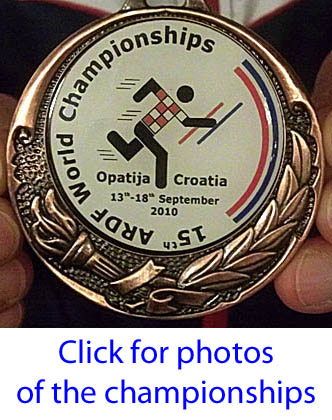
- - - - -
W35 (Females ages 35 and older, 23 in category, 4 required foxes)
Gold Jitka Simackova Czech 49:22 4 Foxes
Silver Ausra Bartkeviciene Lithuania 51:24 4 Foxes
Bronze Irina Platonova Russia 52:38 4 Foxes
Jennifer Harker (22nd) USA 105:30 3 Foxes
- - - - -
W60 (Females ages 60 and older, 11 in category, 3 required foxes)
Gold Galina Petrochkova Russia 43:47 3 Foxes
Silver Svitlana Soloviova Ukraine 54:04 3 Foxes
Bronze Alexandra Bolshakova Russia 81:19 3 Foxes
Karla Leach (7th) USA 86:09 2 Foxes
Ruth Bromer (8th) USA 110:43 2 Foxes
Team USA 2nd of 3 national teams
- - - - -
M40 (Males ages 40 and older, 57 in category, 4 required foxes)
Gold Victor Romanov Russia 39:20 4 Foxes
Silver Valerii Denisov Belarus 40:51 4 Foxes
Bronze Hakan Melin Sweden 43:57 4 Foxes
Vadim Afonkin (12th) USA 50:38 4 Foxes
Jerry Boyd (55th) USA 84:50 2 Foxes
Team USA 18th of 19 national teams
- - - - -
TWO-METERS, SEPTEMBER 15 (150 minute time limit)
M21 (Males of any age, 55 in category, 5 required foxes)
Gold Sergii Shtanko Ukraine 50:45 5 Foxes
Silver Mindaugas Nakvosas Lithuania 51:57 5 Foxes
Bronze Jakub Oma Czech 54:04 5 Foxes
Kenneth Harker (24th) USA 134:48 3 Foxes
- - - - -
M50 (Males ages 50 and older, 51 in category, 4 required foxes)
Gold Mykola Ivanchykhin Ukraine 48:40 4 Foxes
Silver Andres Talver Estonia 53:29 4 Foxes
Bronze Jozef Simecek Slovakia 57:25 4 Foxes
George Neal (8th) USA 62:54 4 Foxes
Dale Hunt (47th) USA 134:20 1 Fox
Jay Hennigan (48th) USA 134:20 1 Fox
Team USA 14th of 16 national teams
- - - - -
M60 (Males ages 60 and older, 48 in category, 3 required foxes)
Gold Viktor Korshunov Ukraine 43:10 3 Foxes
Silver Nazhib Mukhitov Russia 48:13 3 foxes
Bronze Manfred Platzek Germany 50:15 3 foxes
Bob Cooley (12th) USA 70:48 3 Foxes
Harley Leach (15th) USA 74:28 3 Foxes
Dick Arnett (40th) USA 128:27 2 Foxes
Team USA 5th of 15 national teams
- - - - -
EIGHTY-METERS, SEPTEMBER 17 (150 minute time limit)
M21 (Males of any age, 55 in category, 5 required foxes)
Gold Martin Baier Czech 43:17 5 Foxes
Silver Evgeny Panchenko Russia 47:49 5 Foxes
Bronze Jakub Oma Czech 40:00 5 Foxes
Kenneth Harker (50th) USA 122:26 2 Foxes
- - - - -
M50 (Males ages 50 and older, 51 in category, 4 required foxes)
Gold Andres Talver Estonia 53:20 4 Foxes
Silver Jiri Marecek Czech 53:38 4 Foxes
Bronze George Neal USA 54:57 4 foxes
Jay Hennigan (28th) USA 90:15 4 Foxes
Dale Hunt (39th) USA 109:30 4 Foxes
Team USA 7th of 17 national teams
- - - - -
M60 (Males ages 60 and older, 45 in category, 3 required foxes)
Gold Viktor Korshunov Ukraine 52:36 3 Foxes
Silver Nazhib Mukhitov Russia 58:50 3 foxes
Bronze Alexandr Kochergin Kazakhstan 59:08 3 foxes
Dick Arnett (20th) USA 85:55 3 Foxes
Harley Leach (26th) USA 99:59 3 Foxes
Bob Cooley ( 7th) USA 105:30 3 Foxes
Team USA 11th of 14 national teams
- - - - -
TWO-METERS, SEPTEMBER 17 (150 minute time limit)
M40 (Males ages 40 and older, 57 in category, 4 required foxes)
Gold Valeriy Herashchenko Ukraine 86:13 4 Foxes
Silver Hakan Melin Sweden 94:23 4 Foxes
Bronze Daniel Nikolov Bulgaria 96:17 4 Foxes
Vadim Afonkin (13th) USA 121:14 4 Foxes
Jerry Boyd (39th) USA 88:06 1 Fox
- - - - -
W21 (Females of any age, 33 in category, 5 required foxes)
Gold Natalia Giklova Russia 100:13 5 Foxes
Silver Ekaterina Kolomnina Russia 126:52 5 Foxes
Bronze Michaela Omava Czech 127:35 5 Foxes
Lori Huberman (4th) USA 132:13 5 Foxes
- - - - -
W35 (Females ages 35 and older, 24 in category, 4 required foxes)
Gold Nataliya Shcherbatyuk Ukraine 64:30 4 Foxes
Silver Alla Grokholskaya Belarus 70:09 4 Foxes
Bronze Irina Platonova Russia 86:02 4 Foxes
Alla Mezhevaya (15th) USA 132:50 4 Foxes
Jennifer Harker (OT) USA 152:51 1 Fox
- - - - -
W60 (Females ages 60 and older, 11 in category, 3 required foxes)
Gold Svitlana Soloviova Ukraine 138:05 3 Foxes
Silver Galina Petrochkova Russia 121:54 2 Foxes
Bronze Karin Garpestad Norway 131:51 2 Foxes
Ruth Bromer (4th) USA 117:14 1 Fox
Karla Leach (OT) USA 179:57 1 Fox
Text and photos copyright © 2010 Joseph D. Moell. All rights reserved.

 Back to the Championship Foxhunting News page
Back to the Championship Foxhunting News page
Back to the Homing In home page
This page updated 20 April 2023



 When I was a teenager and the space race was in full swing, it wasn't uncommon to hear someone ask, "How are we going to beat the Russians?" I hear the same question asked today, but in a much more friendly way.
When I was a teenager and the space race was in full swing, it wasn't uncommon to hear someone ask, "How are we going to beat the Russians?" I hear the same question asked today, but in a much more friendly way.
 It was better on 80 meters, where signal bounces are rare and bearings are usually very well-defined. The team of Karla Leach KC7BLA and Ruth Bromer WB4QZG (pictured at right) received silver medals for being second only to the Russian team in the category for women over age 60 (W60). (Team scores in each category are aggregates of individual scores in that category. Competitors may not assist one another on the course.) KC7BLA has been participating in ARDF since 2000. This is her fourth time as a competitor in a WC and her first world medal. As a long-time member of
It was better on 80 meters, where signal bounces are rare and bearings are usually very well-defined. The team of Karla Leach KC7BLA and Ruth Bromer WB4QZG (pictured at right) received silver medals for being second only to the Russian team in the category for women over age 60 (W60). (Team scores in each category are aggregates of individual scores in that category. Competitors may not assist one another on the course.) KC7BLA has been participating in ARDF since 2000. This is her fourth time as a competitor in a WC and her first world medal. As a long-time member of  USA's best that day was KF6YKN (pictured at left), who captured a bronze medal in M50 category on 80 meters. George found all of his required four transmitters in just under 55 minutes, which was 97 seconds longer than the Estonian M50 gold medalist took. In M60 category, KF6VSE was seventh in M60, also on 80 meters.
USA's best that day was KF6YKN (pictured at left), who captured a bronze medal in M50 category on 80 meters. George found all of his required four transmitters in just under 55 minutes, which was 97 seconds longer than the Estonian M50 gold medalist took. In M60 category, KF6VSE was seventh in M60, also on 80 meters.


